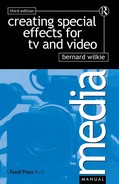Prosthetics
Prosthesis (definition): the replacing of missing parts of the body with artificial substitutes.
In the world of video and movie production the term ‘prosthetics’ is used to mean the application of body make-up to resemble wounds, growths, scar tissue, surgical operations and so on. It has become a specialist subject and its practitioners are artists in their own right.
Generally this work is the province of the make-up experts, but occasionally special effects and make-up need to co-operate.
Body attachments
Science fiction and horror movies often demand that human beings are shown with body deformations and unnatural additions. Characters with two heads, knotted fingers or eyes in the middle of their foreheads are almost commonplace.
Where items have to be attached to human skin much depends on the weight, the size and the use to which the item must be put.
Small devices can be affixed with gum or surgical adhesive tape, the joins being feathered with make-up or morticians’ wax. Larger ones will need integral supports.
A false arm moulded in latex from a plaster cast taken from the performer’s own limb can, where mutilation is required, be shown in close-up. In certain circumstances it can be fitted over the real arm.
Surgical gloves are often used as a basis on which to build claws or deformed hands, but where only a small local abnormality is required it is possible to use just a cut-off glove finger.
For half-human, half-robot characters all sorts of mechanical devices may be attached to the human body. If the edges are disguised with liquid latex and paper tissues they can be made to blend into the flesh without detection.
Dried latex can be removed without difficulty, but body hair should be shaved before application. The combination of latex and paper tissues may be utilised to cover wires (low voltage only, of course) and control cables. Faced with the problem of making a false eye move in the middle of an actor’s forehead some sort of control line would need to be hidden under a false skin.
Directors should always consider cutting away to a reproduction of the original item. A latex cast of the performer’s limbs or torso will look real enough – and suffer no pain. An example might be a control panel stuck to an actor’s chest which in close-up could be smashed inwards with a hammer.
PROSTHETICS
Burns, wounds and physical injuries may be simulated by the application of various make-up materials. Paper tissues, latex and acrylic paints are invariably used to form a base over which conventional make-up is applied as a finishing or blending coat.
Supports for ‘embedded’ weapons can be hidden under a coating of flesh coloured latex.
These rubber models are being used to test simulated accident make-up.

